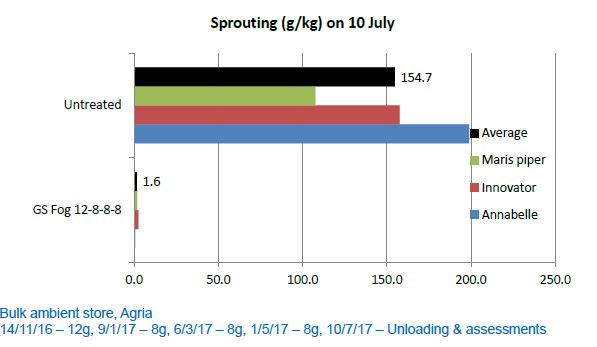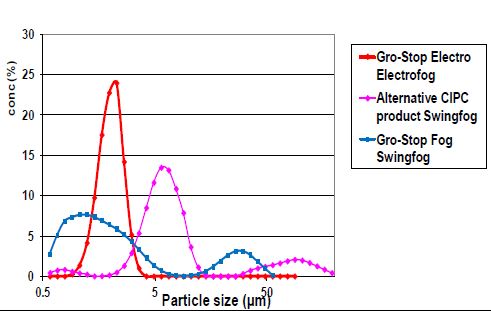Potato sprout suppression: CIPC fogging in 2017 and future development
Given recent regulatory changes how can potato store managers adapt working practices to ensure CIPC fogging remains an effective tool even at new lower dosage levels?
The CIPC Stewardship Group has widely advertised summer 2017 changes to CIPC potato sprout suppressant labels that, amongst other requirements, brought in reduced individual and maximum total doses (detailed in table below). Alongside this, the Sutton Bridge Crop Storage Research (SBCSR) has been on hand to provide the store set up advice necessary to comply with the new requirement for active recirculation of the CIPC fog during and after application.
| Total dose: Fresh market: maximum 24 grams per tonne (but see cold storage limits below). Processing: maximum 36 grams per tonne (including fish & chip shop use) |
| Individual dose: The maximum individual dose is 12 grams per tonne |
| Cold storage for fresh market: Where storage will ultimately be at 5°C or below, only oneapplication should be made, before the crop temperature is reduced below 7°C. |
| Harvest interval: The latest time of application is 14 days before removal from store for sale or processing. |
| Advisors: Recommendations must be made by BASIS qualified advisors who have inspected the crop. |
| Equipment: Application equipment must be inspected and certificated annually by NSTS. |
| Applicators: Personnel must be qualified to NPTC PA1, PA9 and should be members of the NAACCIPC Applicators' Group. |
| Stores: Store managers/owners must have inspected and reported stores as fit for application using the Potato Industry CIPC Stewardship Group (PICSG) Store Checklist. This is a Red Tractor Assurance requirement. |
| Responsibility: Overall responsibility for CIPC use lies with the crop owner – not the store manager, CIPC applicator or BASIS advisor. |
See CIPC
Low dose CIPC programmes: The trial data below shows a programme of low dose applications of Gro-Stop Fog giving effective sprout suppression of three potato varieties from October 2016 to July 2017. This programme of 12g CIPC per tonne followed with three applications of 8g CIPC per tonne fits with the new 36 g CIPC per tonne maximum total dose for processing crops.
CIPC particle size and size distribution: Efficacy of fogging with low dose CIPC is improved if CIPC particles within the fog are close to the optimum size for even distribution and persistence on the stored crop. Can we improve on these features of the fogs we currently use in the UK?
Working with Certis, Frontier is assessing a new Eugenol based CIPC formulation, Gro-Stop Electro, on stored 2017 crop. Eugenol is both an EU approved active substance with no MRL, and a very effective carrier of CIPC. In the assessment Frontier has applied Gro-Stop Electro with its high volume Electrofog applicator. The Gro-Stop Electro formulation optimises CIPC particle size into a narrow single peak of particle sizes when applied through an Electrofog – see graphic below.
Gro-Stop Electro small & even particle size distribution when applied with an Electrofog machine
These trials results demonstrate that by using new formulations of CIPC in combination with high volume Electrofog applicators suitable for the UK, we can further improve the reliability of low dose programmes of CIPC required to comply with the 2017 labels.
Reuben Morris
Crop production specialist
For specific advice for your business related to this blog or any other aspect of crop production get in touch with Frontier.
As a subscriber, you’ll receive email alerts each time a new blog is published so you can always stay updated with the latest advice and insights from our experts




Comments